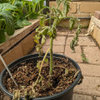Intercropping to Repel Nematodes?
luvs2plant
18 years ago
Related Stories

LIFEHow to Outsmart Backyard Critters
Learn to think like a raccoon, skunk or squirrel to keep your home safe and your garden intact
Full Story
GARDENING AND LANDSCAPINGBid Bad Garden Bugs Goodbye and Usher In the Good
Give ants their marching orders and send mosquitoes moseying, while creating a garden that draws pollinators and helpful eaters
Full Story
GARDENING GUIDESHow to Switch to an Organic Landscape Plan
Ditch the chemicals for a naturally beautiful lawn and garden, using living fertilizers and other nontoxic treatments
Full Story
GARDENING GUIDESGarden Myths to Debunk as You Dig This Fall and Rest Over Winter
Termites hate wood mulch, don’t amend soil for trees, avoid gravel in planters — and more nuggets of garden wisdom
Full StoryMore Discussions







suze9
luvs2plantOriginal Author
Related Professionals
New Mexico Landscape Architects & Landscape Designers · Barrington Landscape Contractors · Broadlands Landscape Contractors · Brunswick Landscape Contractors · Concord Landscape Contractors · Longmont Landscape Contractors · Manhattan Landscape Contractors · Mount Sinai Landscape Contractors · New Cassel Landscape Contractors · Siloam Springs Landscape Contractors · Tigard Landscape Contractors · Twin Falls Landscape Contractors · Portland Siding & Exteriors · Oak Park Siding & Exteriors · Sacramento Siding & Exteriorssuze9
luvs2plantOriginal Author
suze9
carolyn137
torquill
shelly_and_roy
delta_charlie
tomatoman